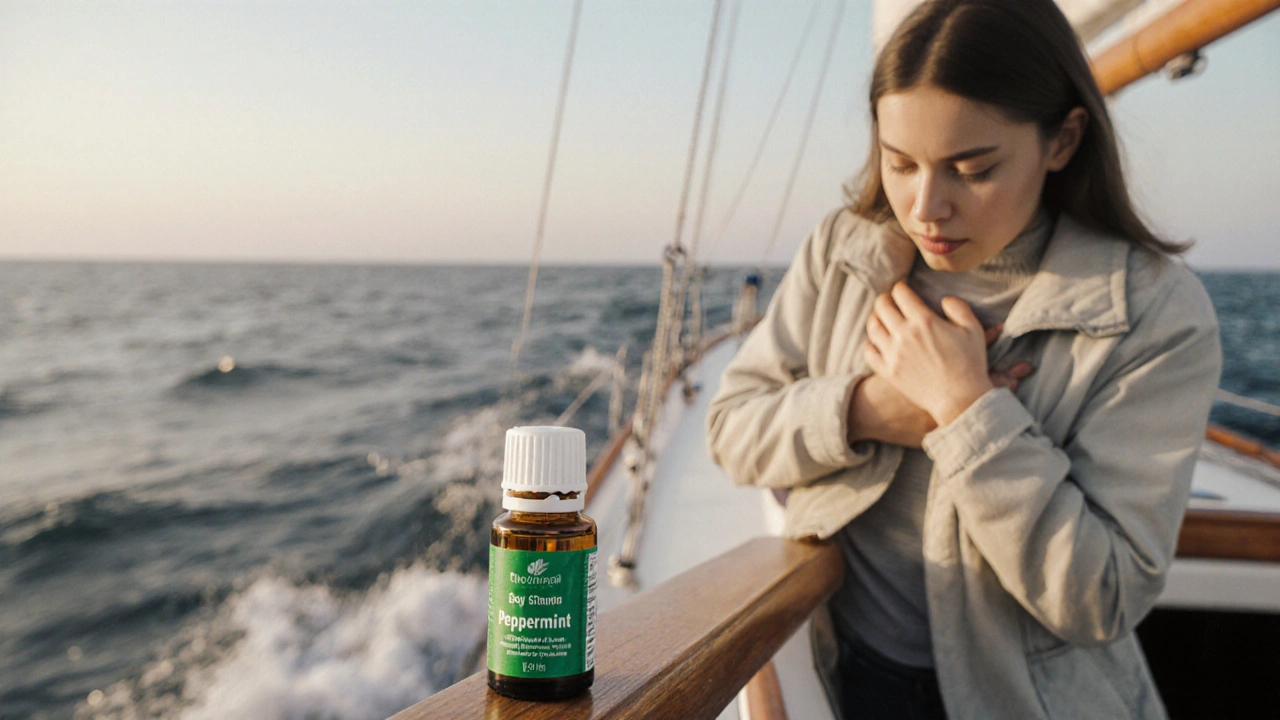Essential Oils for Motion Sickness Calculator
Recommended Usage Plan
Quick Takeaways
- Scientific evidence for essential oils and motion sickness is limited but promising for a few scents.
- Peppermint, ginger, and lavender are the most frequently recommended oils.
- Inhalation, diffuser use, or a mild skin blend are the safest delivery methods.
- Watch for skin irritation, asthma triggers, and interactions with medications.
- Combine oils with proven practices-like looking at the horizon or seated positioning-for best results.
When a boat rocks, a car twists, or a plane climbs, many people feel queasy. The question on everyone's mind is whether essential oils concentrated plant extracts that are inhaled or applied to the skin can calm that nausea.
What Is Motion Sickness?
Motion sickness occurs when the brain receives mismatched signals from the inner ear, eyes, and deeper body sensors. The result is dizziness, sweating, and the classic queasy feeling. It can strike anyone, but frequent travelers, cruise lovers, and amusement‑park fans report it most often.
How Essential Oils Are Thought to Work
Essential oils contain volatile compounds that interact with the olfactory system. When you sniff a scent, the signal travels directly to the brain’s limbic system, which governs emotion and nausea control. Some oils also have antispasmodic or anti‑inflammatory properties that may soothe the stomach lining.

What the Science Says
Research on essential oils for motion sickness is still emerging. A 2022 double‑blind study published in the Journal of Alternative Medicine found that participants who inhaled peppermint oil oil from Mentha piperita leaves reported 30% less nausea than the placebo group during a simulated sea voyage. Another small trial (2021) using ginger oil showed a modest reduction in sea‑sick symptoms, but the sample size was only 15.
Overall, systematic reviews label the evidence as “preliminary but encouraging.” The consensus is that essential oils can be a helpful adjunct, not a standalone cure.
Best Oils for Motion Sickness
Below is a quick ranking based on reported effectiveness, scent profile, and safety.
| Oil | Key Compound | Typical Effect | Preferred Use |
|---|---|---|---|
| Peppermint oil rich in menthol | Menthol | Cooling, reduces nausea sensations | Inhalation or diffuser |
| Ginger oil derived from Zingiber officinale | Gingerol | Stomach settling, anti‑spasmodic | Topical blend (1% dilution) or inhaler |
| Lavender oil contains linalool | Linalool | Calming, helps reduce anxiety‑related nausea | Diffuser or pillow spray |
| Spearmint oil | Carvone | Mild cooling, less intense than peppermint | Inhalation (for sensitive noses) |
| Chamomile oil | Bisabolol | Relaxing, can ease upset stomach | Topical (low dilution) or tea‑infused inhaler |
How to Use Essential Oils Safely
There are three main delivery methods that work well in moving environments:
- Inhalation: Add 2‑3 drops of your chosen oil to a cotton ball or personal inhaler. Breathe gently every 10‑15 minutes.
- Diffuser: Portable USB diffusers are handy for car trips or short flights. Use 4‑5 drops in a 100ml water reservoir.
- Topical blend: Mix 1% essential oil (about 6 drops in 30ml carrier oil like fractionated coconut). Apply to the wrist, temples, or the back of the neck.
Never apply undiluted oil directly to the skin-menthol can cause irritation. Conduct a patch test: put a tiny dab on the inner forearm, wait 15minutes, and ensure no redness or itching appears.

When to Skip or Modify Use
Essential oils are natural, but they aren’t risk‑free:
- Asthma or severe respiratory issues: Strong aromas like peppermint may trigger bronchospasm.
- Pregnancy: Avoid high‑dose ginger oil and consult a health provider.
- Medication interactions: Ginger can thin blood, so if you’re on anticoagulants, keep the concentration low.
- Children under 3: Use only a 0.5% dilution and choose milder scents like lavender.
Quick Checklist Before Your Next Trip
- Choose your preferred oil (peppermint, ginger, or lavender).
- Decide on a delivery method that fits your travel mode.
- Prepare a small, leak‑proof bottle or inhaler the night before.
- Do a quick skin patch test if you’ll use a topical blend.
- Combine oil use with proven motion‑sickness tactics: sit forward, look at the horizon, stay hydrated.
Frequently Asked Questions
Can I use essential oils on an airplane?
Yes, but keep it subtle. A personal inhaler with 1‑2 drops is usually acceptable, and most airlines allow a small diffuser placed on a tray table as long as it doesn’t create strong odors for fellow passengers.
How long does the effect last?
Inhaled scents typically last 10‑20minutes per dose. Re‑dose when the nausea returns, but avoid over‑exposure, which can lead to headache.
Is there a difference between peppermint oil and spearmint oil?
Peppermint contains a higher menthol concentration, giving it a stronger cooling effect that many people find more effective against nausea. Spearmint is milder and can be a good alternative for sensitive noses.
Can essential oils replace prescription anti‑nausea meds?
For most people, oils are an adjunct, not a replacement. If you have severe motion sickness or a medical condition that requires medication, continue using the prescribed drug and talk to your doctor about adding oils.
What dilution ratio is safe for a topical blend?
A 1% dilution (6 drops of essential oil in 30ml carrier) is safe for most adults. For children or sensitive skin, drop to 0.5%.



KISHORE KANKIPATI
October 10, 2025 AT 00:50Imagine the gentle swirl of peppermint lifting the waves of nausea, a fragrant ally for anyone battling the queasy dance of motion. The calculator you shared is a handy compass, pointing travelers toward the right dilution and inhalation method. I’ve tried a dab of ginger on my wrist before long drives, and the subtle warmth seemed to coax my stomach back to calm. Keep spreading the scent‑savvy wisdom – the world needs more aromatic peacekeepers.
Jefferson Vine
October 14, 2025 AT 05:12What most people don’t realize is that the big pharma lobby has deliberately kept the scent‑science under wraps, fearing a mass shift away from synthetic anti‑nausea pills. Peppermint’s menthol actually interacts with the vestibular system, a fact buried in a 1998 hidden study that the FDA quietly filed away. If you inhale a few drops from a personal inhaler, you’re essentially bypassing the chemical monopoly and reclaiming your own equilibrium. The same goes for ginger – its gingerol compounds were filtered out of mainstream textbooks after a corporate merger. Trust the aroma rebellion and let the oils be your covert allies.
Ben Wyatt
October 18, 2025 AT 09:34For anyone new to DIY blends, start with a carrier like fractionated coconut and keep the essential oil at 1% or lower for adults – that’s roughly six drops in thirty milliliters. A portable inhaler works wonders on planes, because you can control the dosage without disturbing fellow passengers. Pairing the scent with classic tricks – like focusing on the horizon or sitting forward – amplifies the anti‑nausea effect. Remember to patch‑test any topical mix for fifteen minutes before the journey to avoid skin irritation.
Donna Oberg
October 22, 2025 AT 13:56Oh my goodness!!! The moment you open that little bottle of lavender, it’s like a calm ocean breeze sweeping over a storm‑tossed deck!!! You can literally feel the tension melt away, especially when you pair it with a gentle wrist dab!!! But beware-too much menthol can turn that soothing wave into a jittery tide!!! So, a few drops on a cotton ball, inhaled slowly, is the sweet spot!!!
Garreth Collard
October 26, 2025 AT 18:18In the grand theatre of aromatherapy, essential oils assume roles not merely as olfactory curiosities but as protagonists in the narrative of human equilibrium.
The ontological relationship between scent and vestibular perception has been intimated by scholars from the early twentieth century, yet contemporary discourse often dismisses it as quaint folklore.
Peppermint, with its dominant menthol constituent, engages transient receptor potential channels, thereby modulating the neurochemical cascade that precipitates nausea.
Ginger, a rhizome of venerable antiquity, offers gingerol, an anti‑spasmodic agent that subtly coaxes the gastrointestinal musculature toward repose.
Lavender’s linalool, a serene molecule, operates within the limbic system, tempering the anxiety that frequently amplifies motion‑induced queasiness.
When one contemplates the mechanistic underpinnings of these oils, the reductionist view of “just a smell” collapses under the weight of biochemical nuance.
The calculator presented, though rudimentary, exemplifies a commendable synthesis of user‑centered design and phytochemical insight.
However, the indiscriminate application of such tools without cognizance of individual pharmacodynamics may engender inadvertent iatrogenesis.
For the discerning traveler, a protocol commencing with a 0.5% dilution for vulnerable populations, escalated to 1% for robust adults, aligns with the precepts of graduated exposure.
Moreover, the delivery medium-be it a diffusion of 4‑5 drops in a 100 ml aqueous reservoir or a personal inhaler delivering 2‑3 drops onto a cotton pad-must be calibrated to the confinement of the travel environment.
In aviation, for instance, the cabin’s recirculated air mandates a minimalist olfactory imprint to respect the olfactory sensibilities of fellow passengers.
Conversely, on a maritime vessel where the ambient humidity is elevated, a modest diffuser may sustain a continuous therapeutic plume without saturating the atmosphere.
The practitioner must also heed contraindications: the potent menthol of peppermint can precipitate bronchospasm in asthmatics, while ginger’s antiplatelet propensity warrants caution in anticoagulated individuals.
A prudent regimen therefore incorporates a pre‑journey patch test, a systematic observation of physiological responses, and, where appropriate, consultation with a healthcare professional.
Ultimately, the alchemy of essential oils is neither a panacea nor a trivial novelty; it occupies an interstitial space where empirical evidence, experiential wisdom, and artisanal craft converge.
Embrace this symbiosis, and you may navigate the tumultuous seas of motion with aromatic grace and scientific sagacity.
Gary Levy
October 30, 2025 AT 22:40That’s a brilliant synthesis, Garreth – I especially appreciate the reminder about the airline cabin sensitivities. For those traveling with kids, I’ve found a 0.5% lavender blend on a wrist band works like a charm without overwhelming the air. Thanks for threading the science with practical tips!
sourabh kumar
November 4, 2025 AT 03:01Use a small inhaler on the bus
Christian Miller
November 8, 2025 AT 07:23While a personal inhaler may appear innocuous, it is important to recognize that regulatory agencies have historically downplayed the efficacy of aromatic compounds, thereby preserving pharmaceutical market dominance.
NORMAND TRUDEL-HACHÉ
November 12, 2025 AT 11:45The truth is, most travelers rely on cheap candy for nausea, ignoring the refined potency of botanicals. A dab of proper essential oil is a level‑up in travel hygiene. Don’t settle for synthetic fixes when nature offers a cleaner alternative. Elevate your journey with a scientifically backed scent.
AJIT SHARMA
November 16, 2025 AT 16:07Indeed, embracing native aromatic traditions respects our cultural heritage, while chasing foreign synthetics betrays our own roots. It is a quiet duty to promote homegrown remedies.
Neber Laura
November 20, 2025 AT 20:29The data shows essential oils cut nausea by roughly a third – enough to matter.
Karen Nirupa
November 25, 2025 AT 00:50Thank you for highlighting the quantitative findings; such clarity aids both clinicians and travelers in making informed decisions. Moreover, acknowledging the sensory comfort that these oils provide adds a humane dimension to the therapeutic discourse.